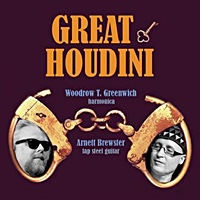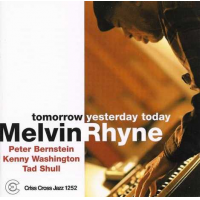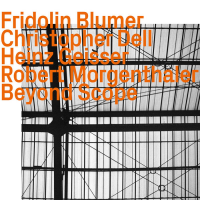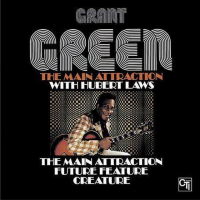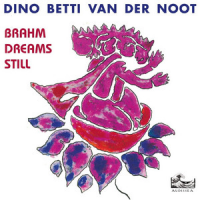Home » Jazz Articles » Liner Notes » The Great Houdini: Arnett Brewster and Woodrow T. Greenwich
The Great Houdini: Arnett Brewster and Woodrow T. Greenwich
Door's open and famous jazz musicians peek in. Some scoff at these bluesmen. Some say "That's really cool." Bunches of jazz students walk past, too, shocked 'cause everything in the jazz program at NYU's Steinhardt School of Culture, Education, and Human Development is s'posed to be jazz, jazz, jazz. And these guys are their teachers.
Yes! Presto, change-o! (as the great magician and escape artist Harry Houdini, neé Ehrich Weisz, might have said) Alakazam! Brewster, the dude strokin' the pretty Asher Electro Hawaiian lap slide guitar, is in a more familiar manifestation the innovative instrumentalist, prolific author and renowned recording artist Bruce Arnold. W. T., the gent with the distinguished wave of white hair who's blowin' harp, is none other than Dr. David Schroeder, accomplished saxophonist and director of the Jazz Studies Program. Amazingly—but not really—they do what they love on The Great Houdini, a blues album that's utterly contemporary and urbanely sophisticated yet also true to the rough, rural roots of our über American music.
The music Brewster/Arnold and Greenwich/Schroeder summon up originated on back porches, at fish fries and in barrelhouses across the southern U.S., and especially in the Mississippi delta, no later than the 19-teens. It still sings to the ear in the 20-somethings. The blues is a classic form that's enticing and profound for locating great depths of nuance and infinite variation in evident simplicity. That may not be a message college music educators typically impart, but maybe they should. Call 'em what you will, Arnett/Bruce and W.T./Dave make the case that having learned a lot doesn't mean you've necessarily forgotten what you always knew.
"I come from Sioux Falls, South Dakota, and when I was growing up in the mid to late '60s a lot of people were playing the blues," remembers Bruce Arnold, who took his nom de bleues from having long been called "Arnie" and also, as far back as a grade school softball team, "Brewster." (Dave Schroeder, born and raised in Carroll, Iowa, at one time lived in Greenwich, CT. The source of Woodrow Tecumseh remains more obscure.) "I mostly listened to blues and that 's pretty much all we played in groups I was in. My whole early upbringing was in the blues."
It's not surprising: back in the mid '60s every rock 'n' roll band featured blues guitar, acknowledged or not. Muddy Waters, Howlin' Wolf, Chuck Berry Bo Diddley, and Kings B.B., Freddie and Albert were models for Buddy Holly, Elvis Presley, Bob Dylan, the Yardbirds, Rolling Stones, Beatles and Beach Boys, San Francisco's psychedelic Quicksilver Messenger Service, Jefferson Airplane, Big Brother and the Holding Company and Grateful Dead, Jimi Hendrix, Santana and hundreds more groups. Bruce Arnold had a cousin who turned him on to Robert Johnson, Lightnin' Hopkins and the Allman Brothers Band.
So Bruce advanced from a wedding band which covered commercial country hits and some jazz standards to an outfit called Stevie and the Studebakers which rocked out on blues and pentatonic scales. Then he attended University of South Dakota where he became more interested in jazz, moved to Boston's Berklee College of Music when it was the font of electric rock/jazz fusion and made it his goal to further use of electric rock/jazz guitar in classically-based compositions and larger ensembles. Subsequently he's performed with the Boston Symphony Orchestra among many other ensembles of every size and instrumentation. He co-founded the collective quartet Act of Finding, has written 60 books of guitar pedagogy, developed theories and practices of 12-tone improvisation, and adapted works by Webern, Shoenberg, Bartók and Debussy for his band Spooky Actions.
He's never left the blues behind; his first album as a leader, released in 1995, was Blue Eleven; in 2010 he issued the trio albums Heavy Metal and The Art of the Blues, both incorporating distillations of the essence. And he started goofing around with Dave Schroeder.
They've known each other for 25 years, starting in Boston. When Bruce was at Berklee, Dave was at New England Conservatory. When Bruce moved to New York City, he joined a band Dave was already in. While a graduate assistant at NYU, Dave gave Bruce a job, and when Dave became head of the Jazz Program, Bruce stayed on. Apart from his academic work, Schroeder's leads the genre-crunching Combo Nuvo, playing tenor and soprano saxophones, flute and pennywhistle besides harmonica.
"About a year ago Dave asked me if I played slide," says Bruce. "I'd played a little bit a ways back. It's been quite a journey to get it happening again—you have to learn to play in tune, you can't just pick a fret—but now I just try to have a good time. I wanted something like this, more down to earth, basic and sort of a release. I think that goes for Dave, too. He's a great saxophonist and composer—those are his mainstays. But this blues comes from his heart."
Indeed, The Great Houdini is a heartfelt album, full of the intimate sound of two buddies rolling out their blues. The songs emerge without big production, presumption or pretense. The album starts with Arnold's "Tarnation," bell-like harmonics and an engaging bass line intersecting with harmonica huffs-and-puffs that give way to a lonesome line. It ends with Schroeder's ballad "A Simple Thanks," conveying a hint of Great Plains gospel. In between lie many shades of blues, evoking mystery, nostalgia, a sense of adventure, the desire to ramble.
The sensibility is immediate and spontaneous, not self-consciously retro, though Arnold gave the tracks he "composed" (as always in the blues, borrowings and adaptations are allowed) titles from Old West slang. "Tarnation" is hell. "Widow Maker," its pace almost painfully slow, is a horse that's hard to break. "Windies," meaning tall tales, has a beguiling melody. "Wagtail" is a little fast—a wag-tail, according to LegendsofAmerica.com, was what prostitutes were called in the Rocky Mountains.
"A lot of blues have 'train' in the name," Arnold explains of "Dakota Train Blues"—and harmonica players, particularly those from the Southeastern Piedmon whose style Schroeder favors, often imitated trains. "Asher" is the brand of Arnold's lap slide guitar.
The tunes by Schroeder have their own slants. Their features include a unison beginning and melodic twist for "Six Cents Blues," an urgency on "Look Out!," the tossing of the lead back and forth on "Dem Dere Shuffle," the longer phrasing of "A Simple Thanks."
About that thanks: the blues reminds us that what seems simple can be fundamental. Anyone who know the blues—as a feeling, as a low down, easy goin' or hard driving rhythm, as a three chord song that can get a personal story into the air so all listeners sigh, having had the same troubles, insights and joys—knows themselves. Woodrow Tecumseh Greenwich and Arnett Brewster aren't disguises Dave Schroeder and Bruce Arnold don when they sit down to jam, but as Harry Houdini was to Ehrich Weisz, alter egos the musicians have held within themselves since childhood. As Weisz emerged from small town dime museums and sideshows to stun the world as a magician who really did escape from handcuffs, locked trunks and straightjackets, so Schroeder and Arnold throw off the shackles of their hard earned virtuosity, refreshed in the light of new blues. Voilá! The Great Houdini!
Liner Notes copyright © 2026 Howard Mandel.
The Great Houdini can be purchased here.
Contact Howard Mandel at All About Jazz.
Howard is a Chicago-born writer, editor, author, arts reporter for National Public Radio, consultant and videographer. Visit Howard at howardmandel.com.
Track Listing
Tarnation; Six Cents Blues; Widow Maker; Look Out!; Windies; Wagtail; Dakota Train Blues; Asher; Dem Dere Shuffle; A Simple Thanks.
Personnel
Bruce Arnold
guitarWoodrow T. Greenwich
harmonicaAlbum information
Title: The Great Houdini | Year Released: 2023 | Record Label: Self Produced
Tags
PREVIOUS / NEXT
Support All About Jazz
 All About Jazz has been a pillar of jazz since 1995, championing it as an art form and, more importantly, supporting the musicians who make it. Our enduring commitment has made "AAJ" one of the most culturally important websites of its kind, read by hundreds of thousands of fans, musicians and industry figures every month.
All About Jazz has been a pillar of jazz since 1995, championing it as an art form and, more importantly, supporting the musicians who make it. Our enduring commitment has made "AAJ" one of the most culturally important websites of its kind, read by hundreds of thousands of fans, musicians and industry figures every month.

